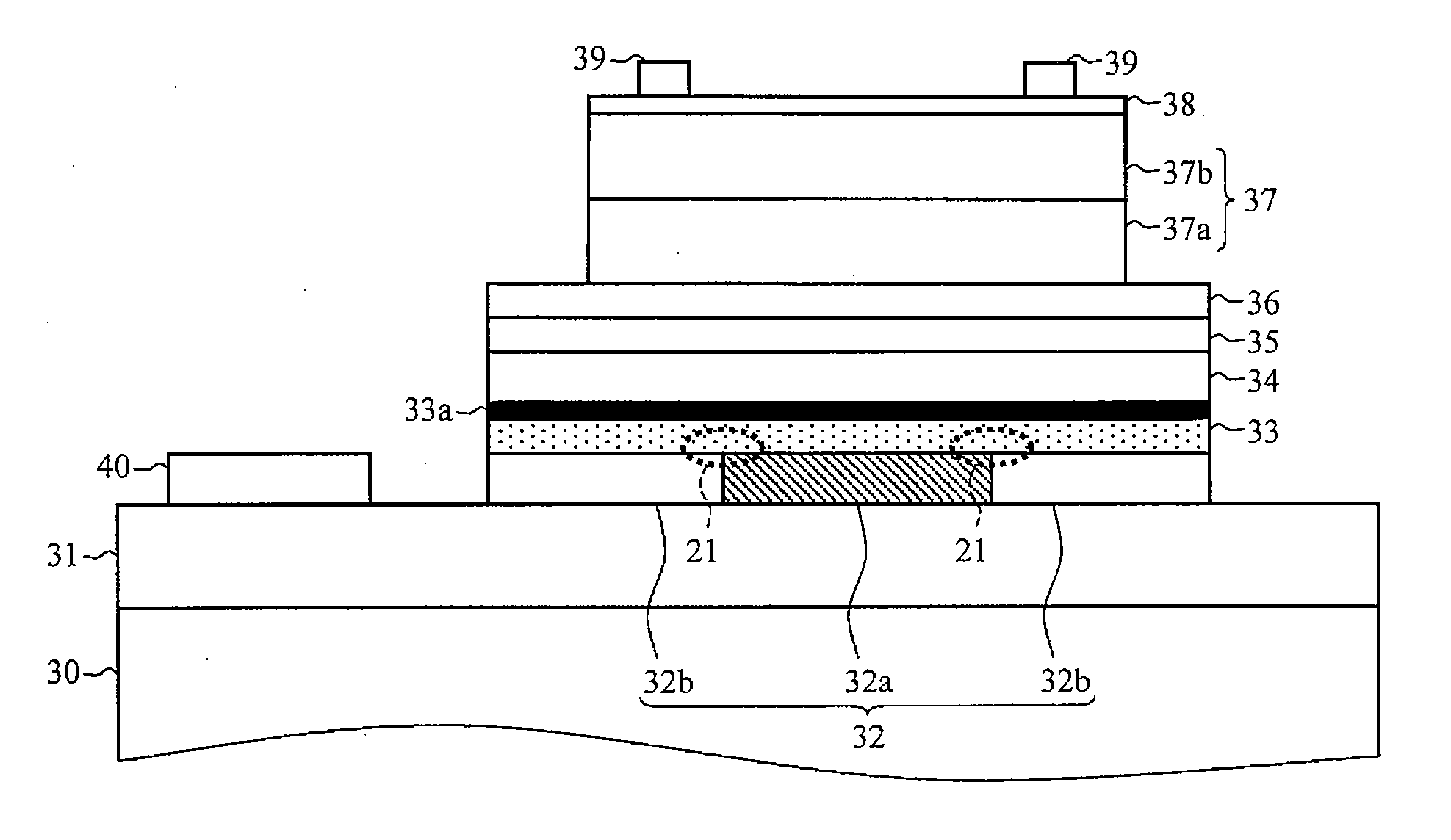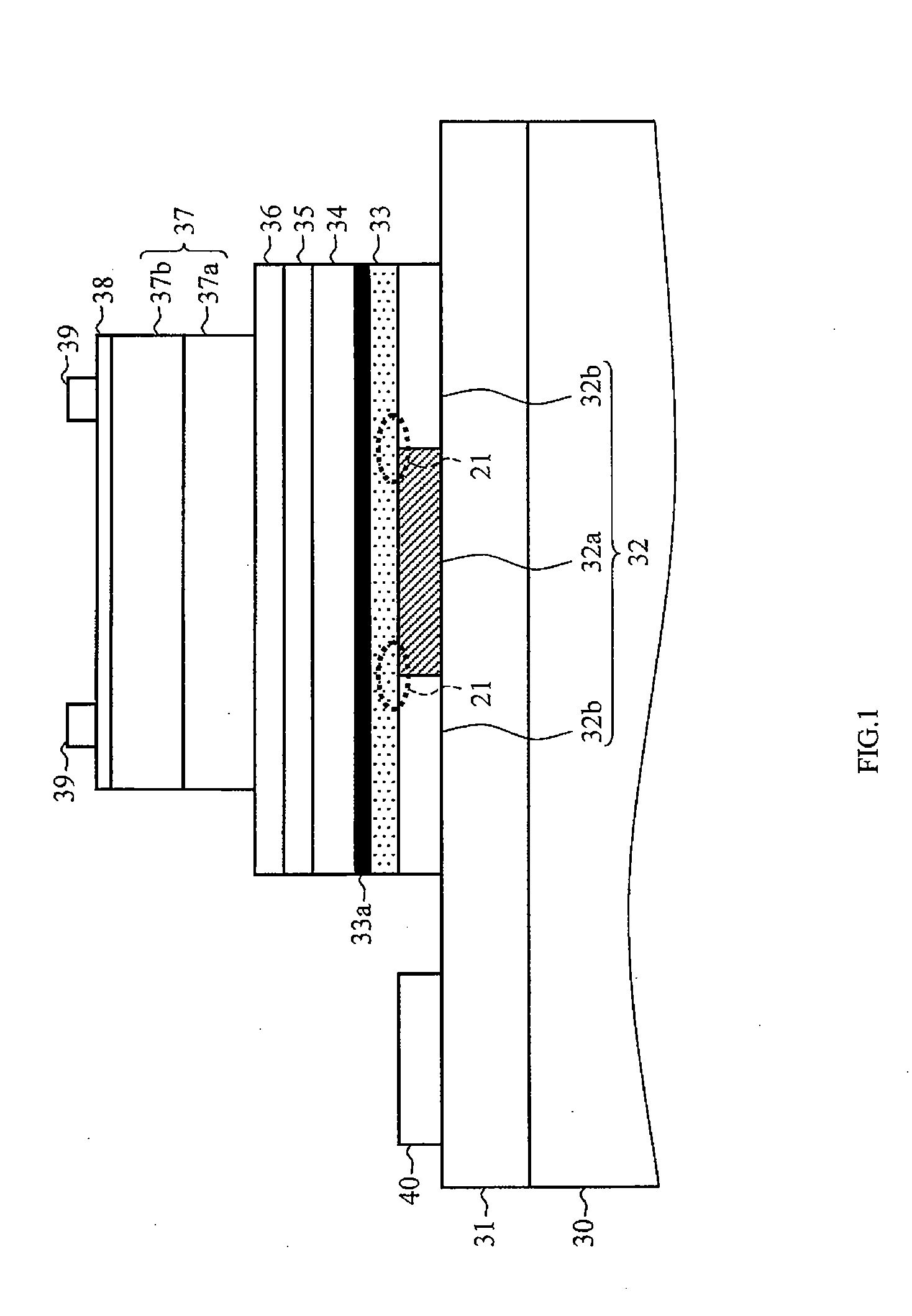Avalanche photodiode
a photodiode and avalanche technology, applied in the field of avalanche photodiodes, can solve the problems of poor element manufacturing yield, inability to reach, and difficult to precisely control the zn heat diffusion, and achieve the effect of suppressing edge breakdown without highly precise control
- Summary
- Abstract
- Description
- Claims
- Application Information
AI Technical Summary
Benefits of technology
Problems solved by technology
Method used
Image
Examples
first embodiment
[0031]FIG. 1 is a schematic view of a device element cross-section illustrating an APD according to a first embodiment. The APD of FIG. 1 is an electron injection-type APD in which an n electrode layer 31, an n electrode connecting layer 32, a buffer layer 33, an avalanche multiplication layer 34, an electric field control layer 35, a band gap gradient layer 36, a low-concentration light absorbing layer 37a, a p-type light absorbing layer 37b, and a p electrode layer 38 are sequentially stacked, and a light absorbing portion 37 including at least the low-concentration light absorbing layer 37a and the p-type light absorbing layer 37b forms a mesa shape. The APD of FIG. 1 adopts an embedded n electrode structure in which the n electrode connecting layer 32 has an n-type region 32a that is disposed to be closer to the inner side than the periphery of the avalanche multiplication layer 34 and the periphery of the mesa of the light absorbing portion 37, when viewed from a stack directio...
second embodiment
[0037]FIG. 3 is a schematic view of a device element cross-section illustrating an APD according to a second embodiment. The APD of FIG. 3 is also an electron injection-type APD that adopts the embedded n electrode structure, similar to the APD of FIG. 1. The difference of the APD of FIG. 3 and the APD of FIG. 1 is that the doping portion 33a does not need to be formed in the buffer layer 33 of the APD of FIG. 3, the APD is a semiconductor with a composition different from a composition of each of the buffer layer 33 and the avalanche multiplication layer 34, and the buffer layer 33 has a band gap wider than a band gap of the avalanche multiplication layer 34.
[0038]The composition of each layer from the n electrode layer 31 to the buffer layer 33 is the same as the composition of the APD of FIG. 1. The avalanche multiplication layer 34 is InAlGaAs that has a low doping concentration. The electric field control layer 35 is p-InAlGaAs. The band gap gradient layer 36 is an InAlGaAs lay...
third embodiment
[0041]FIG. 5 is a schematic view of a device element cross-section illustrating an APD according to a third embodiment. The p electrode layer 38, the p-type light absorbing layer 37b, the low-concentration light absorbing layer 37a, the band gap gradient layer 36, the electric field control layer 35, the avalanche multiplication layer 34, the buffer layer 33, the n electrode connecting layer 32, and the n electrode layer 31 are sequentially stacked on the substrate 30, and the p electrode 39 and the n electrode 40 are formed. This structure corresponds to the case where the semiconductor structure according to the second embodiment is vertically reversed. In this case, since the n electrode connecting layer 32 exists in an upper portion, instead of the substrate side, formation of the n layer by the injection of the Si ions in the cases of the first and second embodiments is not needed, and the mesa shape may be simply determined. That is, by disposing the n electrode connecting lay...
PUM
 Login to View More
Login to View More Abstract
Description
Claims
Application Information
 Login to View More
Login to View More - R&D
- Intellectual Property
- Life Sciences
- Materials
- Tech Scout
- Unparalleled Data Quality
- Higher Quality Content
- 60% Fewer Hallucinations
Browse by: Latest US Patents, China's latest patents, Technical Efficacy Thesaurus, Application Domain, Technology Topic, Popular Technical Reports.
© 2025 PatSnap. All rights reserved.Legal|Privacy policy|Modern Slavery Act Transparency Statement|Sitemap|About US| Contact US: help@patsnap.com



